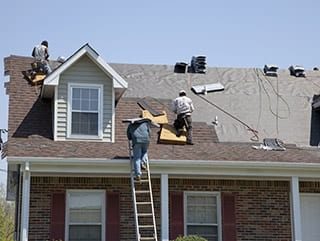Hiring a Professional Roofer
Are you considering replacing your roof but don’t know where to start? Don’t worry – this blog post is here to help guide you through the entire process. We’ll cover everything from understanding what type of roofing material works best for your home, to tips on how to save money during a roof replacement project. So if you’re ready to take the plunge and make sure your home is safe and secure, read on!
A roof is one of the most important parts of a home, and it is important to keep it in good condition. A well-maintained roof can last for many years, but eventually, it will need to be replaced.
When it is time to replace your roof, there are a few things you should keep in mind. First, you need to choose the right type of roofing material for your home. There are many different options available, and you should select the one that best suits your needs and budget.
Next, you need to find a reputable contractor to do the job. Make sure you get several estimates before hiring anyone, and always get references from past customers. Finally, be sure to get everything in writing before work begins.
Replacing a roof is a big job, but it doesn’t have to be overwhelming. By following these steps, you can ensure that the process goes smoothly and that your new roof will provide years of protection for your home.
Why You Should Replace Your Roof
A roof is one of the most important parts of a house, and it needs to be in good condition to protect the rest of the structure. If your roof is more than 20 years old, it’s probably time for a replacement. Here are some other reasons why you should replace your roof:
- Your roof is leaking: Even a small leak can cause serious damage to your home if it’s not fixed quickly.
- There are missing or damaged shingles: Missing or damaged shingles leave your roof vulnerable to water damage and leaks.
- Your energy bills are rising: A new roof can help insulate your home and keep energy costs down.
- You’re selling your home: A new roof can add value to your home and make it more attractive to potential buyers.
Steps to Replacing Your Roof
1. Contact a roofing contractor: Before you begin the process of replacing your roof, it’s important to contact a reputable roofing contractor in your area to get a professional opinion and estimate.
2. Remove the old roofing materials: Once you’ve decided to replace your roof, the next step is to remove the old roofing materials. This can be done by a professional roofer or by yourself, if you feel comfortable doing so.
3. Install the new roof: After the old roofing materials have been removed, it’s time to install the new roof. This process will vary depending on the type of roof you’re installing, but most roofs can be installed in one day.
4. Inspect the new roof: Once the new roof has been installed, it’s important to inspect it for any problems or defects. If everything looks good, you can enjoy your new roof!
Common Materials Used for Roof Replacement
There are a few different types of materials that can be used for roof replacement, and the most common ones are asphalt shingles, metal roofs, and rubber roofing. Asphalt shingles are the most popular type of roofing material in the United States, and they come in a variety of colors and styles to choose from. Metal roofs are becoming more popular as they are more durable and long-lasting than asphalt shingles, but they can be more expensive. Rubber roofing is a newer type of roofing material that is starting to gain popularity because it is environmentally friendly and easy to install.
Hiring a Professional Roofer vs. Doing It Yourself
 When it comes time to replace your roof, you have two main options: hiring a professional roofer or doing the job yourself. While there are benefits to both approaches, there are also some important considerations to keep in mind. Here’s a look at the pros and cons of each option to help you make the best decision for your situation.
When it comes time to replace your roof, you have two main options: hiring a professional roofer or doing the job yourself. While there are benefits to both approaches, there are also some important considerations to keep in mind. Here’s a look at the pros and cons of each option to help you make the best decision for your situation.
Hiring a Professional Roofing Contractor
The biggest advantage of hiring a professional roofer is that they have the experience and expertise to get the job done right. They also have access to the necessary tools and equipment, which can save you time and money. In addition, most roofing contractors offer warranties on their workmanship, which can give you peace of mind knowing that your investment is protected.
However, there are also some disadvantages to consider before hiring a professional roofer. First, it’s important to research different contractors in your area to find one that you can trust. There’s also the cost factor to consider – professional roofers typically charge more than doing the job yourself. Finally, if something does go wrong with the roof after it’s been installed, you may have to deal with the contractor directly to get it fixed, rather than being able to fix it yourself.
Doing It Yourself
If you’re handy around the house and feel confident in your ability to install a new roof, then doing it yourself may be the way to go. The biggest benefit of doing the job yourself is that you can save money on labor costs. You also don’t have to worry about researching and trusting a contractor – you can be sure that the job will be done right.
Of course, there are some downsides to consider before tackling a DIY roofing project. First, it’s important to make sure that you have the necessary tools and equipment for the job. Second, it’s important to do your research so that you understand exactly what needs to be done and how it should be done correctly. Finally, if something does go wrong with your new roof after installation, you may not have any recourse if it was installed incorrectly.
Overall, whether you decide to hire a professional roofer or do the job yourself is ultimately up to you. However, careful consideration of all factors involved is key in order to ensure that your roof is installed correctly and safely.
Cost Considerations
When it comes time to replace your roof, there are a few cost considerations to keep in mind. First, the type of roof you choose will affect the cost of materials and installation. For example, asphalt shingles are typically the most affordable option, while metal roofs are usually more expensive. Second, the size and pitch of your roof will also impact the cost. A larger or steeper roof will require more materials and labor, and therefore will be more expensive to replace. Finally, any special features or details on your roof (such as skylights or chimneys) will need to be taken into account when budgeting for a replacement.
With all of these factors in mind, it’s important to get several estimates from different contractors before making a final decision. Be sure to ask about the type of materials they recommend, as well as their experience installing roofs similar to yours. Getting multiple bids will help you ensure you’re getting the best value for your money when replacing your roof.
Maintenance and Care of a New Roof
Once your new roof is installed, it’s important to take care of it to ensure that it lasts for many years. Here are some tips for maintaining and caring for your new roof:
- Inspect your roof regularly, especially after severe weather. Look for any signs of damage or leaks and have them repaired promptly.
- Keep your gutters and downspouts clean and free of debris. Clogged gutters can lead to water damage on your roof.
- Trim trees and shrubs near your home so that they don’t rub against the roof or drop leaves and other debris onto it.
- If you have a fireplace, have the chimney inspected and cleaned regularly to prevent fires.
By following these simple tips, you can keep your new roof in great shape for many years to come!
Replacing your roof is a big job, and it’s important to make sure you are properly prepared before beginning. We hope that this guide has given you an idea of the steps involved in replacing your roof and everything else you need to know about the process. If you have any further questions or would like advice on how to get started with replacing your roof, don’t hesitate to reach out for help from professionals who can answer all of your questions and walk you through every step of the way.
Visit our social media for more details about professional roofer.
